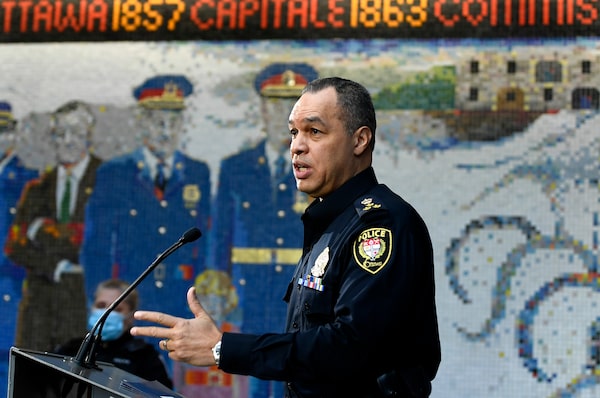
Ottawa Police Chief Peter Sloly speaks at a news conference on Feb. 4.Justin Tang/The Canadian Press
Former Ottawa police chief Peter Sloly defended his response to last winter’s convoy protests in passionate testimony before the Emergencies Act inquiry on Friday, pushing back on allegations that the police service’s planning had been inadequate and that he personally had made missteps.
He rejected suggestions that he had been too controlling, and bristled at the notion that another police force should have taken over command of the response to the out-of-control protests, which he had previously described as lawless.
The inquiry was shown evidence on Friday that the Ottawa police were quickly overwhelmed. Within days of the protests arriving in the capital, the force’s senior command was already talking about calling in the military, according to minutes from an internal police meeting. Prime Minister Justin Trudeau publicly ruled out any military role soon afterward.
The inquiry, known as the Public Order Emergency Commission, is tasked with determining whether the federal government contravened the law when it invoked the Emergencies Act in response to the protests. The act gave the government extraordinary temporary powers, which it used to crack down on demonstrators.
The former chief’s testimony capped more than a week of evidence from senior commanders of the Ottawa police service and Ontario Provincial Police.
Through the testimony of those police officials, and through documents, the inquiry’s commissioner, Justice Paul Rouleau, has been presented with conflicting evidence about what police did, what powers they needed and whether the Emergencies Act needed to be invoked.
The police officials who testified ahead of Mr. Sloly described widespread dysfunction and tension within the Ottawa force. They often identified Mr. Sloly as a source of conflict.
On Friday, Mr. Sloly disputed much of that testimony.
The former chief, who is the inquiry’s highest profile witness so far, will take the stand again on Monday. He resigned on Feb. 15, more than two weeks after protesters opposed to the federal government and pandemic restrictions plunged the city into chaos. The protests, which brought downtown Ottawa to a standstill by blocking streets with large trucks and other vehicles, ended after a massive police operation that began three days later.
Police were criticized for standing by as protesters organized supply lines of fuel for the trucks parked in front of Parliament Hill, held open-pit fires, indiscriminately set off fireworks beside office buildings and condos and blared their horns at all times of the day and night.
In previous testimony, Patricia Ferguson, Acting Deputy Chief of the Ottawa police, said Mr. Sloly appeared unwilling to relinquish control to other police forces that had sent reinforcements to the city, even as the protesters became more and more difficult to dislodge.
Emergencies Act wasn’t needed to quell convoy protests, Ontario police force says
In his own testimony on Friday, Mr. Sloly dismissed the idea that the Ontario Provincial Police should have taken over the response. He said he disagreed with Deputy Chief Ferguson’s testimony. But he also told the inquiry that other police forces that came to help the city during the protests had to work under Ottawa police command. He described this as his “red line.”
If other police services couldn’t agree, he said, “we’d probably have to go back to the drawing board in some other way to get the resources.”
Under Ontario’s Police Services Act, the Ottawa police chief or police services board can formally ask the OPP to take responsibility for an incident. The provincial attorney general or the Ontario Civilian Police Commission can also make the same request if the police force with jurisdiction is “not providing adequate and effective police services.”
Mr. Sloly said he doesn’t know of any police service ever having relinquished jurisdiction during his career. In a separate interview with the commission’s counsel, a summary of which was tabled at the inquiry, he said Ottawa police could not have “done anything materially differently,” considering the “unprecedented national security crisis” they were facing.
Mr. Sloly became emotional as he spoke about the impact the convoy protests had on Ottawa police. Taking long pauses and with red eyes, the former chief said there should be more compassion for officers who were working under what he called “inhuman circumstances.”
“It was too cold, and it was too much. But they did their very best. And I am grateful to them,” he said.
Misinformation and disinformation “was off the charts,” Mr. Sloly added. “It was crushing to the members’ morale.”
Still, he blamed his deputies for not disclosing critical information to him. And he accused the media of misrepresenting police in coverage of the protests.
The only regret Mr. Sloly expressed about his leadership was in relation to a comment he made early in the protests. He told the commission that, when he said there may not be “a police solution” to the demonstration, sparking the public’s ire, what he meant to say was that the Ottawa force couldn’t end the protests on its own.
Mr. Sloly rejected the idea, expressed in an interview with the commission by one of his subordinates, that there was a disconnect between the police plan before the protests arrived and the available intelligence about the protesters, which suggested they were organized and might remain for a long time.
Mr. Sloly was particularly heated in his rebuttals of previous evidence suggesting he had not been in favour of negotiating with the protesters. In an interview with the commission, Ottawa Interim Chief Steve Bell said Mr. Sloly saw “no room to negotiate and preferred utilizing enforcement” if protesters couldn’t be convinced to leave outright.
“This concept of Peter Sloly as being some sort of ultra-enforcement-driven leader is a narrative that someone has constructed to attack my character, but bears no resemblance whatsoever to my actual record,” Mr. Sloly told the inquiry.